#so many feelings like 'did you seriously just write 2k words about a gacha game you played for a single day'
Text
I'm a loser who both spends too much time playing gacha games and loves to hear myself talk, so here's another game review style post, this time covering my first day playing Break My Case. This time I'm not even being a little hater! I'm a lover! I'm cringe! I'm free! I love you Coly! I love you ikemen gacha games!!!!!!!
Break My Case is a new puzzle-music-adventure mobile game from Coly, the developers behind Mahoutsukai no Yakusoku and On Air. More relevant to BMC/BreMai is their game Stand My Heroes, with which it shares a writer, some gameplay elements, and of course a naming convention. Coly has developed a bit of a cult following for their unique status in the Japanese mobile gaming world: they're a company that was founded by women and hires women to make games for women. They put a lot of soul into their games. From the start, BMC is no different!
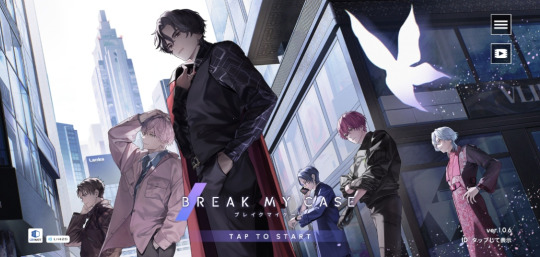
"Could you have pulled a clean version of this image from the internet so it didn't have all the game junk" no. it's my tumblr and you get my screenshots.
I (with help from friends) overviewed the initial Break My Case announcement back when it dropped. You can read that here! I said in that post that I thought a "dark rhythm game" would be a really cool direction for the game… and that's more or less what we got! GO ME!!!!!
First: the game's presentation is fantastic. Super slick graphical design and just amazing atmosphere. The sound design of this game is incredible. Genuinely. Really, really, good. All the music is amazing—I'm not knowledgeable enough to say anything other than "IT SLAPS!", but it totally does slap. The illustrations for the cards are all wonderfully atmospheric in and of themselves, and are just a delight to look at on the homescreen with its chill background music. Even just navigating menus is a sleek, seamless experience. The live2d is well-done, although it clashes a tad with the art style for a bit of an uncanny look at times.
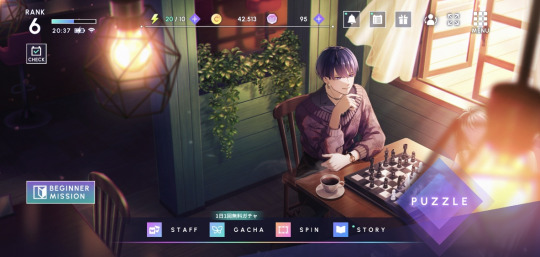
The atmosphere! The atmospheeeeeeere!!!
Of course, the draw to this game is the characters and story, so let's jump into that. I'll admit right now that I read the story through a machine translation—I have aaaalmost enough Japanese knowledge to fill in the gaps, especially since the story is fully voiced, but I'm definitely not getting the full nuance of the story that someone fluent in Japanese is going to get. THAT SAID, after completing the prologue, I was definitely intrigued enough that I want to continue slogging through the MTL just to read more! There's a great setup, centered around the bar Aporia and its three modes—a daytime cafe, a nighttime members-only bar, and, secretly, a "fixer" service who'll help anyone with any problem. Our main character, a woman who was just forced to quit her job at a corrupt company, gets hired to replace Aporia's eccentric owner while he goes on a who-knows-how-long vacation. The owner also has the role of "tail"—as in, the tail a lizard sheds to avoid being eaten. If anything in the fixer service goes wrong, it's the owner who takes the fall and the blame. This hasn't come to mean much in practice yet in the (quite short) prologue, but it's a fascinating setup. The story promises to touch on themes of the threads that weave our lives together, how small meetings can lead to massive life changes, and whether any human being is truly replaceable, even in our modern corporate world where people are treated like cogs in a machine. According to a staff interview, there are a handful of references to Stand My Heroes in BreMai, but the games' settings aren't otherwise closely linked.


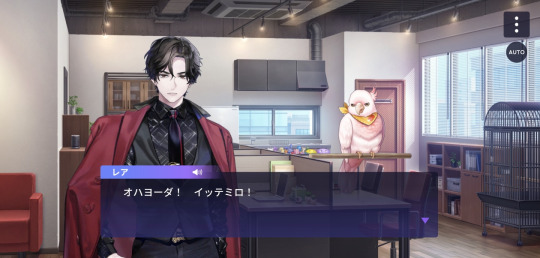
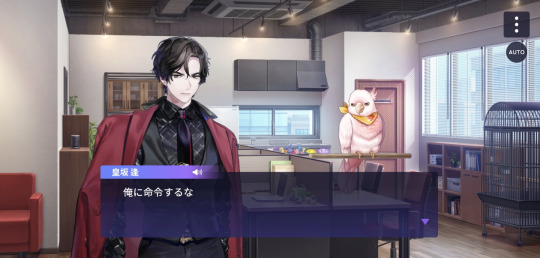
Rough translation in alt text. The Aporia manager Ai may be the most mysterious, intimidating character, but he also beefs with a parrot the first time you meet him, so...
All the characters are staff at Aporia with various unique roles and background. The prologue just gives you a little bit of each of them, but everyone does show up, and they all have interesting dynamics with each other already. Ai, the stern manager, has some history with the MC that he refuses to divulge, and goes so far as to force psychologist Riku to agree to not look into it. The range of relationships among the staff run the gamut from the calm and mature friendship between fortune teller Kiho and art teacher Kyoya, to the unfaltering dedication of Yu to his ex-mafioso savior Tomose, to the ridiculous Takeru and Soyogu who spend their first appearance waking up after having gotten black-out drunk together the night before. My favorite dynamic of all so far is that of Kou and Mao—Kou is a playboy who insists he's not a playboy, and is introduced evading a woman by… asking the icy Mao to pretend to be his boyfriend so that she thinks he's taken and gay and leaves him alone. Which Mao exasperatedly agrees to, telling Kou that he's used up his allotment for this month which ohmygod how often does Kou do this. Kou if you're asking this guy to pretend to be your gay lover so often he gives you a monthly limit I think you might just have to admit you want him to actually be your gay lover, Kou, oh my god—

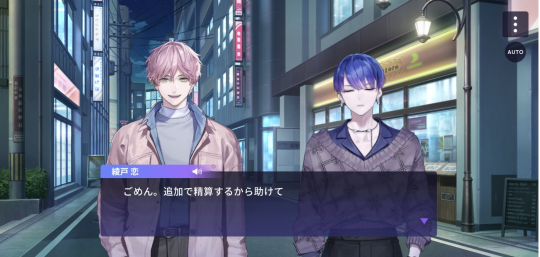
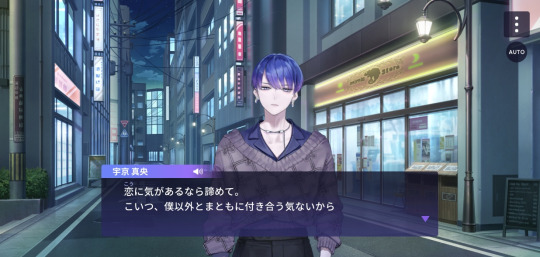
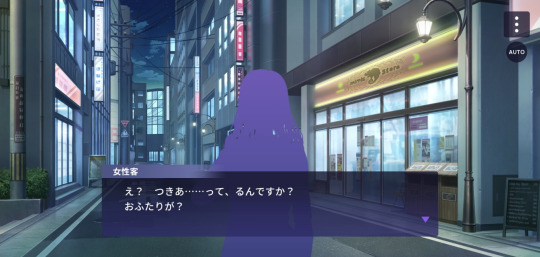

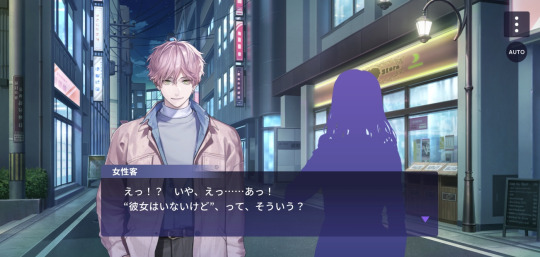
Rough TL in alt text. Kou is letting the implication do all the heavy lifting here. He technically never said he was dating Mao. Technically.
youtube
On to the gameplay. There's gameplay! Unique gameplay! Good unique gameplay! Oh my god, uncharted joseimuke territory! The main gameplay mode is a match-3 puzzle game with rhythm elements. As in other rhythm games, each song in the game is its own level, more or less. (Each character has two unique songs, and three songs shared with the other members of their unit.) You set up a team with cards you've collected from the gacha, which determine your power level and special skills. The "leader" of the team has to be the character whose level you've selected. The puzzle gameplay is a tile-swapping match 3—think bejeweled or candy crush—but the tiles you've matched are only cleared once a bar sliding across the screen hits them, clearing them in tune with the song. Everything cleared in a single swipe of the bar ups the combo counter. There's also a life system, where if the bar slides across the screen without clearing a single match, you lose a life… But the bar moves pretty slow. You're not likely to game over or even lose a single life any time soon. There are more difficult versions of the levels I've yet to unlock, so I'm sure the life meter becomes relevant then. There's also "auto" and "loop" features if you want to grind a level over and over for exp and items, but, of course, the computer can't score as high as you playing it yourself.
And, really, it's fun to play, so why would you want to!? The sound of matches clearing with the music is so satisfying and really makes you want to combo as high as possible. Once you've matched some tiles, you can't move them again, nor use them in a second match (eg, in a cross shape), so if you want to maximize your combo and make as many matches as possible with what's on the board, you have to think ahead about which matches you're going to make. The bar slowly crossing the screen adds a visual timed element that gives some urgency to putting all the matches together. It definitely feels like a game you can pick up an instinct for over time, which is super fun.
All in all, a really solid, enjoyable little puzzle game. It would be fun to play even without the promise of anime boys. Stand My Heroes is also a match-3, for the record, which is what really cements the two games as being part of the same series.
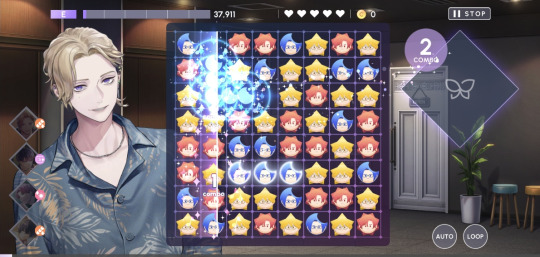
Admittedly, the anime boy staring at you while you play musical candy crush is a little disconcerting.
The second gameplay mode is "Snap'n Spin", a… gameplay-lite mode that just puts chibi characters in random strange situations and lets you take pictures of them. The mode is explained to be a video game within the world of BreMai, so it's not even trying to be realistic or relevant to anything else in the game. Once you take your pokemon snaps of the boys, they get a fun little caption. You can save up to 40 pictures in your album. Other than being cute, the main way this mode interfaces with the rest of the game is that it's the primary way to unlock card stories for the cards you pulled in gacha.
This gameplay mode is... cute? I guess? It being so disconnected from the style and aesthetics of the entire rest of the game felt weird. The chibis are adorable, so it has that going for it. And I do like some of the captions you get on the photos afterwards. My favorite were the scenes you catch of a character drinking, and then the caption reveals their current favorite drink. That's a delightful detail for a game set in a bar. Mostly, though, this mode left me wondering "why?" ...And I imagine the answer is something like "because merchandisable chibi characters are a requirement for joseimuke games." This mode could've been anything so long as these cute, starry little dudes were in it.
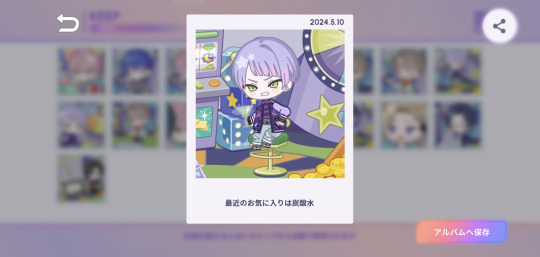
Urara here hated the drink and the caption revealed that, lately, his favorite thing is sparkling water. He's the youngest character in the cast, so I guess he hasn't grown into booze yet...
One last feature I want to mention is the jukebox. Like many games, BreMai has a music player that lets you listen to tracks from the game… But its music player is, genuinely, a fully-featured music player app with shuffle, repeat, lyric displays, and even background play that works when you're in another app or your phone is off. What! Wild! When I first learned a few days ago that BreMai had a built-in player for its BGM tracks, my first thought was "Well, what's stopping someone from downloading the game just to use the music player and never spending a cent on it? Wouldn't you rather have the songs on spotify so you at least get a pittance of ad revenue, in that case? It's more than nothing."
But having played the game now, I see what they did to prevent that, lol. You don't unlock the songs in the jukebox until you get an SS score on the song's level. Which, I mean, that's normal rhythm game stuff, of course. Can't fault that decision. But, as in other gacha rhythm games, your score in a level depends on the power of your team of cards, and the cards you get from the initial handful of pulls aren't gonna get you anywhere near an SS score without significant investment. So you're either buying in-game currency to buy upgrade items, more gacha pulls, or both. Of course, you can also put a bunch of time into grinding for upgrade items—they drop from levels. Gacha currency is harder to come by. So you're not getting songs in the player without actually playing the game lmfao. The character solo songs in particular (the ones with vocals rather than just instrumentals) also require you to build up rapport with that character—the game calls it "Nice". You build up Nice with them by playing their other songs and using their cards in levels. It takes 1000 Nice on a character to unlock their song. In my first day of playing, I was able to get one character to about 250 Nice, another to 200, and a handful more with a few points, so it builds at an okay pace. There's ways to pay to speed up the grinding for Nice and for upgrade items with things like level skip tickets. So, basically: you're not getting that music player to a useful state without investing either money or time, lmao. Is paying-or-grinding to get cool music you can listen to while not playing the game more "worth it" than the usual freemium game goals of better units, new in-game outfits, or prettier card illustrations? ...Honestly, maybe it is? It's novel, at least.
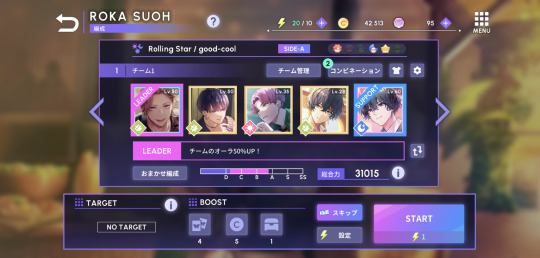
All gacha rhythm games have the same card select screen, don't they. These were my cards' levels after my first day of play, and you can see they didn't quite reach a suggested score of "A", much less the maximum "SS".
But I do want to stress, the monetization is, for the most part, pretty easy to ignore. Nothing in-your-face. The button to go to the shop screen is a different color, but it's not flashing with an eternal indicator, it's not popping up at every second, it's just sitting there alongside all the other menu buttons. The game isn't shoving timers in your face at all times—there's a stamina meter, which is mildly annoying, but you get ten plays when it's full, and if you're just playing casually you're probably not going to want to play the puzzle game over and over enough to fully deplete that. I know the bar is on the damn floor here but Tokyo Debunker seriously made me realize how bad it can be with mobile game monetization. BreMai is freemium, yeah, but as far as dark patterns go, it's not egregiously bad.
So, the verdict: if you're a joseimuke game fan and aren't afraid to play a game that probably won't get an English port and doesn't even have a fan translation yet (which I realize is already counting out 99.99% of people), definitely give this one a try. See if you like the gameplay—it really is worth trying—and do check out the story if you've got the ability. Or just look at the pretty anime boys.

#suchobabbles#break my case#do you know how self-conscious i feel posting this. its actually so bad#so many feelings like 'did you seriously just write 2k words about a gacha game you played for a single day'#'why are you trying to pretend to be a game reviewer you have no qualifications and nobody cares about your opinions'#'stop roleplaying like youre a columnist blogger in the 2010s youre literally a tumblr nobody'#but im fighting the demons and im posting this anyways
19 notes
·
View notes